Natural food company Hain Celestial (NASDAQ:HAIN) missed analysts' expectations in Q1 CY2024, with revenue down 3.7% year on year to $438.4 million. It made a non-GAAP profit of $0.13 per share, improving from its profit of $0.08 per share in the same quarter last year.
Hain Celestial (HAIN) Q1 CY2024 Highlights:
- Revenue: $438.4 million vs analyst estimates of $463.4 million (5.4% miss)
- Adjusted EBITDA: $43.8 million vs analyst estimates of $39.2 million (11.7% beat)
- EPS (non-GAAP): $0.13 vs analyst estimates of $0.07 ($0.06 beat)
- Lowered full year guidance for organic sales growth and adjusted EBITDA
- Gross Margin (GAAP): 22.1%, up from 21.4% in the same quarter last year
- Free Cash Flow of $30.24 million, up 104% from the previous quarter
- Organic Revenue was down 3.7% year on year
- Market Capitalization: $598.3 million
Sold in over 75 countries around the world, Hain Celestial (NASDAQ:HAIN) is a natural and organic food company whose products range from snacks to teas to baby food.
The company was established in 1993 by Irwin D. Simon. His aim was to offer consumers wholesome and better-for-you food choices. Throughout time, the company has grown through both organic growth and acquisitions, with its 1999 acquisition of the Celestial Seasonings brand as a key milestone.
Today, in addition to the Celestial Seasonings teas, Hain Celestial’s product portfolio includes Terra Chips vegetable chips, Earth's Best baby food and formula, Garden of Eatin’ corn tortilla chips, and Alba Botanica personal and skincare offerings to name a few. The core customer is therefore broad but is generally the head of an everyday American household. This individual does the grocery shopping for the family and values healthier food options at reasonable prices from trusted and established brands.
The company’s brands can be found in many locations selling food and snacks, including supermarkets, club stores, large-format general merchandise retailers, and convenience stores. Additionally, Hain Celestial also sells to food service companies, meaning you can find the company’s products in corporate and school cafeterias, for example.
Shelf-Stable Food
As America industrialized and moved away from an agricultural economy, people faced more demands on their time. Packaged foods emerged as a solution offering convenience to the evolving American family, whether it be canned goods or snacks. Today, Americans seek brands that are high in quality, reliable, and reasonably priced. Furthermore, there's a growing emphasis on health-conscious and sustainable food options. Packaged food stocks are considered resilient investments. People always need to eat, so these companies can enjoy consistent demand as long as they stay on top of changing consumer preferences. The industry spans from multinational corporations to smaller specialized firms and is subject to food safety and labeling regulations.
Competitors offering healthier packaged foods include General Mills (NYSE:GIS), Kellogg's (NYSE:K), and Conagra Brands (NYSE:CAG), all of which did not start in organic and natural foods but have since pivoted towards this segment.Sales Growth
Hain Celestial carries some recognizable brands and products but is a mid-sized consumer staples company. Its size could bring disadvantages compared to larger competitors benefiting from better brand awareness and economies of scale. On the other hand, Hain Celestial can still achieve high growth rates because its revenue base is not yet monstrous.
As you can see below, the company's revenue has declined over the last three years, dropping 4.6% annually. This is among the worst in the consumer staples industry, where demand is typically stable.
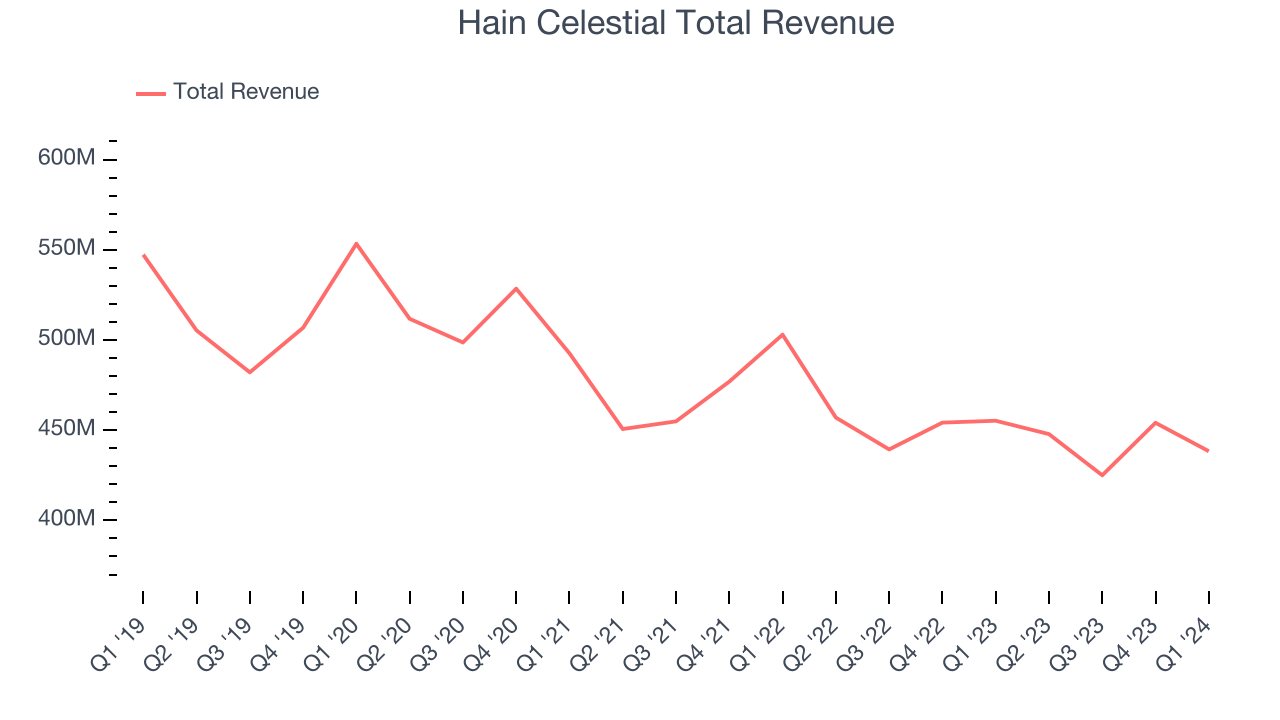
This quarter, Hain Celestial missed Wall Street's estimates and reported a rather uninspiring 3.7% year-on-year revenue decline, generating $438.4 million in revenue. Looking ahead, Wall Street expects sales to grow 4.9% over the next 12 months, an acceleration from this quarter.
Gross Margin & Pricing Power
Hain Celestial's gross profit margin came in at 22.1% this quarter, in line with the same quarter last year. That means for every $1 in revenue, a chunky $0.78 went towards paying for raw materials, production of goods, and distribution expenses.
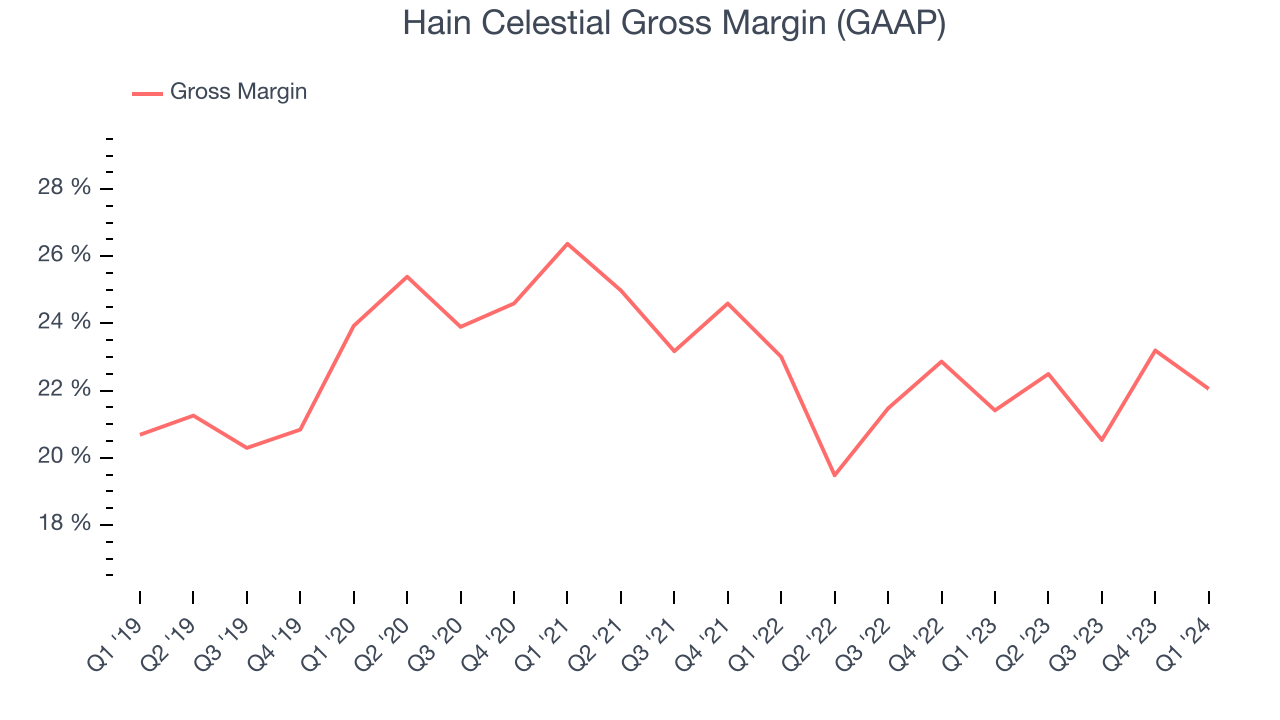
Hain Celestial has poor unit economics for a consumer staples company, leaving it with little room for error if things go awry. As you can see above, it's averaged a paltry 21.7% gross margin over the last two years. Its margin, however, has been trending up over the last 12 months, averaging 3.9% year-on-year increases each quarter. If this trend continues, it could suggest a less competitive environment.
Operating Margin
Operating margin is an important measure of profitability accounting for key expenses such as marketing and advertising, IT systems, wages, and other administrative costs.
In Q1, Hain Celestial generated an operating profit margin of negative 6.4%, down 10.7 percentage points year on year. Conversely, the company's gross margin actually increased, so we can assume the reduction was driven by operational inefficiencies and a step up in discretionary spending in areas like corporate overhead and advertising.
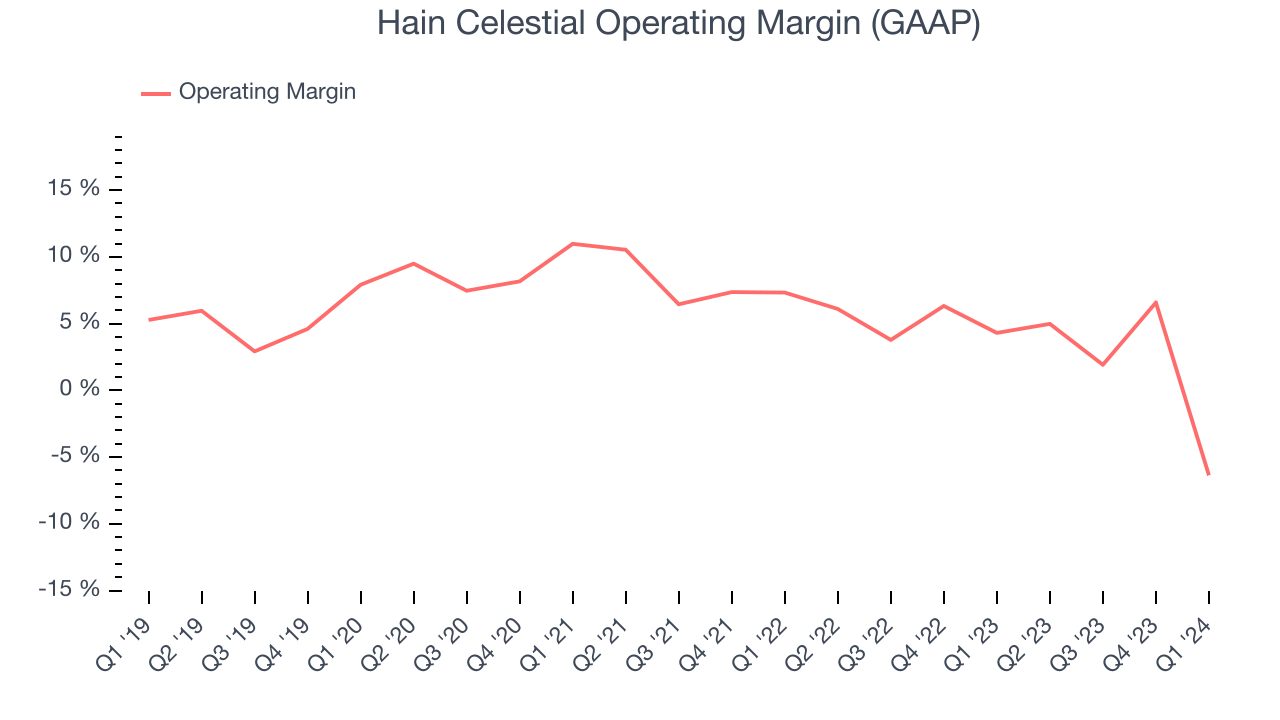
Zooming out, Hain Celestial was profitable over the last eight quarters but held back by its large expense base. It's demonstrated subpar profitability for a consumer staples business, producing an average operating margin of 3.5%. On top of that, Hain Celestial's margin has declined by 3.3 percentage points on average over the last year. This shows the company is heading in the wrong direction, and investors are likely hoping for better results in the future.
Note that this quarter's operating margin was impacted by a one-time exceptional impairment charge.
EPS
These days, some companies issue new shares like there's no tomorrow. That's why we like to track earnings per share (EPS) because it accounts for shareholder dilution and share buybacks.
In Q1, Hain Celestial reported EPS at $0.13, up from $0.08 in the same quarter a year ago. This print beat Wall Street's estimates by 74.1%.
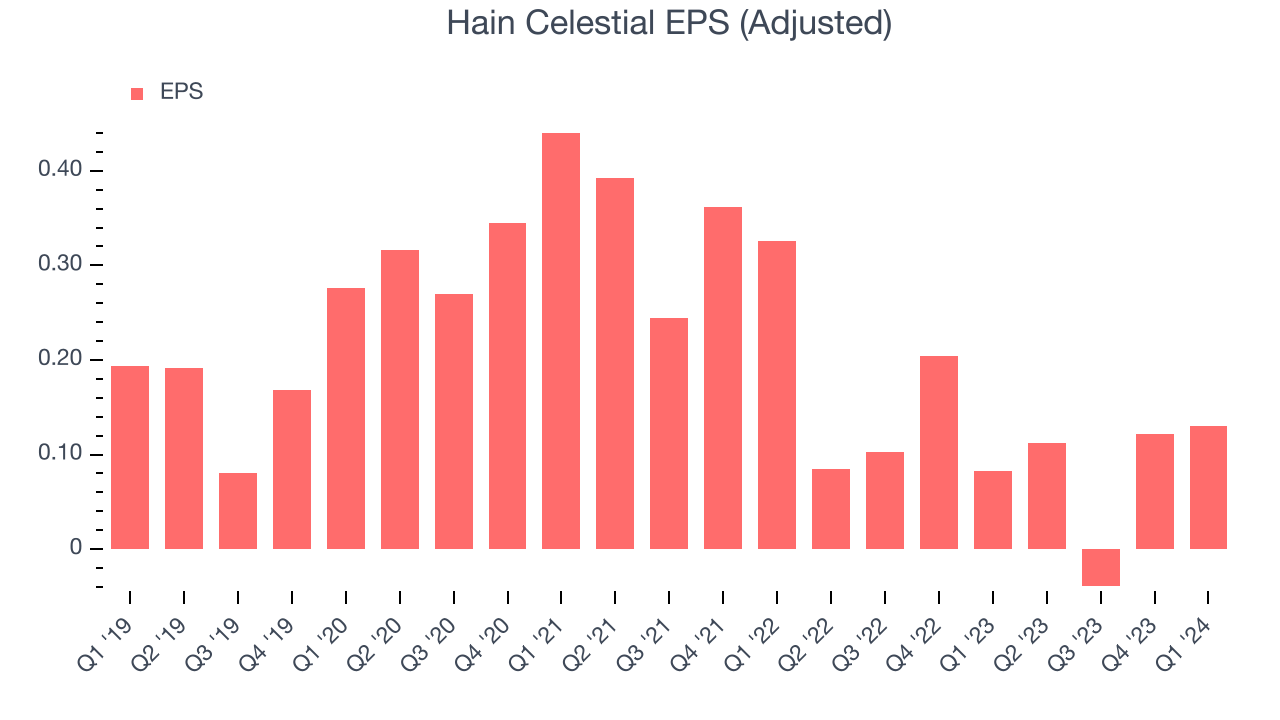
Between FY2021 and FY2024, Hain Celestial's EPS dropped 76.4%, translating into 38.2% annualized declines. We tend to steer our readers away from companies with falling EPS, especially in the consumer staples sector, where shrinking earnings could imply changing secular trends or consumer preferences. If there's no earnings growth, it's difficult to build confidence in a business's underlying fundamentals, leaving a low margin of safety around the company's valuation (making the stock susceptible to large downward swings).
On the bright side, Wall Street expects the company's earnings to grow over the next 12 months, with analysts projecting an average 25.5% year-on-year increase in EPS.
Cash Is King
If you've followed StockStory for a while, you know we emphasize free cash flow. Why, you ask? We believe that in the end, cash is king, and you can't use accounting profits to pay the bills.
Hain Celestial's free cash flow came in at $30.24 million in Q1, up 40.1% year on year. This result represents a 6.9% margin.
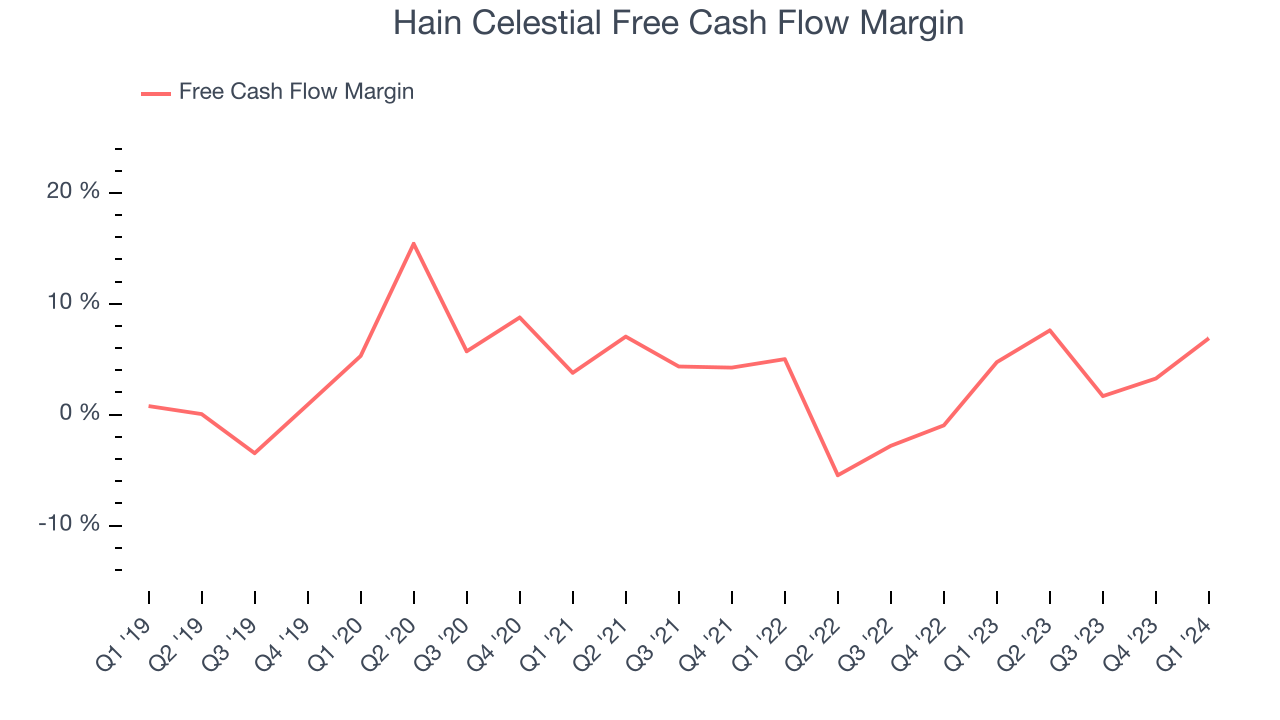
Over the last eight quarters, Hain Celestial has shown mediocre cash profitability, putting it in a pinch as it gives the company limited opportunities to reinvest, pay down debt, or return capital to shareholders. Its free cash flow margin has averaged 1.9%, subpar for a consumer staples business. However, its margin has averaged year-on-year increases of 6 percentage points over the last 12 months. Continued momentum should improve its cash flow prospects.
Return on Invested Capital (ROIC)
EPS and free cash flow tell us whether a company was profitable while growing revenue. But was it capital-efficient? Enter ROIC, a metric showing how much operating profit a company generates relative to how much money the business raised (debt and equity).
Hain Celestial's five-year average ROIC was 5.8%, somewhat low compared to the best consumer staples companies that consistently pump out 20%+. Its returns suggest it historically did a subpar job investing in profitable business initiatives.
The trend in its ROIC, however, is often what surprises the market and drives the stock price. Unfortunately, Hain Celestial's ROIC averaged 3.5 percentage point decreases over the last few years. Paired with its already low returns, these declines suggest the company's profitable business opportunities are few and far between.
Balance Sheet Risk
As long-term investors, the risk we care most about is the permanent loss of capital. This can happen when a company goes bankrupt or raises money from a disadvantaged position and is separate from short-term stock price volatility, which we are much less bothered by.
Hain Celestial reported $49.55 million of cash and $777.5 million of debt on its balance sheet in the most recent quarter. As investors in high-quality companies, we primarily focus on two things: 1) that a company's debt level isn't too high and 2) that its interest payments are not excessively burdening the business.
With $158.5 million of EBITDA over the last 12 months, we view Hain Celestial's 4.6x net-debt-to-EBITDA ratio as safe. We also see its $26.57 million of annual interest expenses as appropriate. The company's profits give it plenty of breathing room, allowing it to continue investing in new initiatives.
Key Takeaways from Hain Celestial's Q1 Results
We were impressed by how significantly Hain Celestial blew past analysts' EPS expectations this quarter. On the other hand, its revenue unfortunately missed analysts' expectations and its organic revenue missed Wall Street's estimates. Looking forward, full year guidance for organic sales growth and adjusted EBITDA were lowered. Overall, this was a mediocre quarter for Hain Celestial. The stock is flat after reporting and currently trades at $6.61 per share.
Is Now The Time?
Hain Celestial may have had a tough quarter, but investors should also consider its valuation and business qualities when assessing the investment opportunity.
We cheer for all companies serving consumers, but in the case of Hain Celestial, we'll be cheering from the sidelines. Its revenue has declined over the last three years, but at least growth is expected to increase in the short term. And while its projected EPS for the next year implies the company's fundamentals will improve, the downside is its declining EPS over the last three years makes it hard to trust. On top of that, its gross margins make it more challenging to reach positive operating profits compared to other consumer staples businesses.
Hain Celestial's price-to-earnings ratio based on the next 12 months is 16.3x. While there are some things to like about Hain Celestial and its valuation is reasonable, we think there are better opportunities elsewhere in the market right now.
Wall Street analysts covering the company had a one-year price target of $11.08 per share right before these results (compared to the current share price of $6.61).
To get the best start with StockStory, check out our most recent stock picks, and then sign up to our earnings alerts by adding companies to your watchlist here. We typically have the quarterly earnings results analyzed within seconds of the data being released, and especially for companies reporting pre-market, this often gives investors the chance to react to the results before the market has fully absorbed the information.
